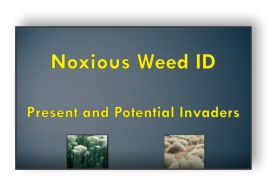| 2020 Field Days |

|
ARS Field Day 'Virtual Tour'
Due to the COVID 19 pandemic, NPARL was forced to cancel our regular dryland field days typically held in June. In their place we've added a number of “virtual” reports, including:
- narrated research findings/updates from Drs. Tatyana Rand, Jay Jabro, Natalie West and Upendra Sainju (with more planned);
- narrated introductions to our three new scientists at NPARL;
- an ID pamphlet for surveying Mormon cricket, and
- recordings of two weed ID webinars we hosted in late June, the first on Palmer amaranth and other herbicide resistant crop weeds, and the second on rangeland weed identification.
We will also be adding additional updates as the field season moves forward.
Virtual Research Reports:
Title: Effects of shifting rainfall levels on wheat stem sawfly and its biological control
Presenter: Sidney ARS Research Ecologist Tatyana Rand | tatyana.rand@usda.gov
Description: Results shared from an experiment studying climatic influences on pest insects, specifically looking at the effects of increasing and decreasing rainfall amounts on wheat stem sawfly infestations; control by natural enemies, and their combined impacts on wheat yield.
Title: Previous crop roots effects on soil compaction
Presenter: Sidney ARS Soil Physicist Jay Jabro | jay.jabro@usda.gov
Description: Report on a dryland study evaluating the effect of various rooting systems on soil compaction in 2-yr durum rotations with camelina, carinata and a cover crop mix planted in place of fallow in a sandy loam soil.
Title: Linking agent abundance with habitat and weed genotypes to improve leafy spurge biocontrol
Presenter: Sidney ARS Research Ecologist Natalie West | natalie.west@usda.gov
Description: Discussion of a new large-scale study evaluating the existing leafy spurge biocontrol program. The three-state dy is designed to tease out limitations to biological control of leafy spurge with current agents. Preliminary results from the first year of the ongoing study are presented.
Title: Soil chemical properties with long-term cropping sequence and nitrogen fertilization
Presenter: Sidney ARS Research Soil Scientist Upendra Sainju | upendra.sainju@usda.gov
Description: Discussion of the impacts of cropping sequence and varied nitrogen applications on grain yield, soil organic matter, phosphorus, potassium and pH in a dryland study at Sidney, MT.
Meet Our Newest Scientists:
NPARL recently added three new researchers to its scientific staff. Learn more about them and their research interests here.
Dr. Joshua Campbell, Pollination Specialist
Joshua.Campbell@usda.gov
Dr. Carissa Wonkka, Weed Ecologist
Carissa.Wonkka@usda.gov
Dr. Sadikshya Dangi, Soil Microbiologist
sadikshya.dangi@usda.gov
Mormon Cricket ID Handout:
For citizen scientists, or just plain curious folks, this pamphlet provides tips on identifying Anabrus simplex, or Mormon cricket, a rangeland insect that can form large migratory bands that move into neighboring crops, threatening farmland all across the western US.
For more information: Dr. Robert Srygley, Research Ecologist | robert.srygley@usda.gov
Weed ID Webinars:
And finally, brush up on your Weed ID skills with these two presentations held on June 25-26, 2020.
Webinar #1: Palmer Amaranth Identification and Management and Herbicide Resistant Weeds, by Richland County Extension Agent Tim Fine. Originally presented live on June 25, 2020.
Description: Fine discusses how to identify Palmer amaranth and distinguish it from other pigweed species in the region to prevent the introduction of this devastating crop weed into Montana. Fine also describes the steps to take if someone believes they’ve found the weed. In addition, Fine addresses other herbicide-resistant crop weeds already present in Eastern Montana in his presentation.
Webinar #2: Noxious Weed Identification: Present and Potential Invaders, by NPARL Bioscience Technician Kim Mann. Originally presented live on June 26, 2020.
Description: Mann provides tips on identifying and distinguishing noxious rangeland weeds commonly found in the MonDak, along with those threatening to invade. Mann has more than 30 years of experience with weed identification and biocontrol. In addition to an overview of noxious weeds listed in the state, she also addresses a locally listed weed, baby’s breath, currently considered a noxious weed in Daniels, Richland, Sheridan and Valley counties in northeastern MT.
Please Note: Participants in the original live sessions of these webinars were able to collect MT pesticide applicator recertification points. However, points are not available for those viewing the recordings.


